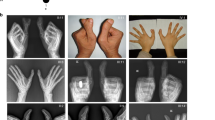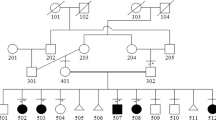Abstract
Chondrodysplasia Grebe type (CGT) is an autosomal recessive disorder characterized by severe limb shortening and dysmorphogenesis. We have identified a causative point mutation in the gene encoding the bone morphogenetic protein (BMP)–like molecule, cartilage-derived morphogenetic protein–1 (CDMP-1). The mutation substitutes a tyrosine for the first of seven highly conserved cysteine residues in the mature active domain of the protein. We demonstrate that the mutation results in a protein that is not secreted and is inactive in vitro. It produces a dominant negative effect by preventing the secretion of other, related BMP family members. We present evidence that this may occur through the formation of heterodimers. The mutation and its proposed mechanism of action provide the first human genetic indication that composite expression patterns of different BMPs dictate limb and digit morphogenesis.
This is a preview of subscription content, access via your institution
Access options
Subscribe to this journal
Receive 12 print issues and online access
$209.00 per year
only $17.42 per issue
Buy this article
- Purchase on Springer Link
- Instant access to full article PDF
Prices may be subject to local taxes which are calculated during checkout
Similar content being viewed by others
References
Hall, B.K. Embryonic bone formation with special reference to epithelial-mesenchymal interactions and growth factors, in Bone; A Treatise, vol. 8, Mechanisms of Bone Development and Growth (ed. Hall, B.K.) 137–192 (CRC Press, Boca Raton, Florida, 1994).
Wozney, J.M. et al. Novel regulators of bone formation: molecular clones and activities. Science 242, 1528–1534 (1988).
Luyten, P.P. et al. Purification and partial amino acid sequence of osteogenin, a protein initiating bone differentiation. J. Biol. Chem. 264, 13377–13380 (1989).
Sampath, T.K. et al. Bovine osteogenic protein is composed of dimers of OP-1 and BMP-2A, two members of the transforming growth factor β super-family. J. Biol. Chem. 265, 13198–13205 (1990).
Hogan, B.L.M. Bone morphogenetic proteins: multifunctional regulators of vertebrate development. Genes Dev. 10, 1580–1594 (1996).
Chang, S.C. et al. Cartilage-derived morphogenetic proteins: new members of the transforming growth factor–β superfamily predominantly expressed in long bones during human embryonic development. J. Biol. Chem. 269, 28227–28234 (1994).
Storm, E.E. et al. Limb alterations in brachypodism mice due to mutations in a new member of the TGFβ-superfamily. Nature 368, 639–643 (1994).
Storm, E.E. & Kingsley, D.M. Joint patterning defects caused by single and double mutations in members of the bone morphogenetic protein (BMP) family. Development 122, 3969–3979 (1996).
Thomas, J.T. et al. A human chondrodysplasia due to a mutation in a TGF-β superfamily member. Nature Genet. 12, 315–317 (1996).
Grebe, H., Achondrogenesis: ein Einfach rezessives Erbmerkmal. Folia Hered. Pathol. 2, 23–29 (1952).
Quelce-Salgado, A. A new type of dwarfism with various bone aplasias and hypoplasias of the extremities.Acta Genet. 14, 63–66 (1964).
Lin, K., Thomas, J.T., McBride, O.W. & Luyten, F.P. Assignment of a new TGF-β superfamily member, human cartilage-derived morphogenetic protein–1, to chromosome 20q11.2. Genomics 34, 150–151 (1996).
Daopin, S., Piez, K., Ogawa, Y. & Davies, D.R. Crystal structure of transforming growth factor-β2: an unusual fold for the superfamily. Science 257, 369–373 (1992).
Venkataraman, G., Sasisekharan, V., Cooney, C.L., Langer, R. & Sasisekharan, R. Complex flexability of the transforming growth factor β superfamily. Proc. Natl. Acad. Sci. USA 92, 5406–5410 (1995).
Griffith, D.L., Keck, P.C., Sampath, T.K., Rueger, D.C. & Carlson, W.D. Three-dimensional structure of recombinant human osteogenic protein-1: structural paradigm for the transforming growth factor β superfamily. Proc. Natl. Acad. Sci. USA 93, 878–883 (1996).
Kopito, R.R. ER quality control: the cytoplasmic connection. Cell 88, 427–430 (1997).
Lopez, A.R., Cook, J., Deininger, P.L. & Derynck, R. Dominant negative mutants of transforming growth factor–beta 1 inhibit the secretion of different transforming growth factor–beta isoforms. Mol. Cell. Biol. 12, 1674–1679 (1992).
Hawley, S.H.B. et al. Disruption of BMP signals in embryonic xenopus ectoderm leads to direct neural induction. Genes Dev. 9, 2923–2935 (1995).
Aono, A. et al. Potent ectopic bone-inducing activity of bone morphogenetic protein-4/7 heterodimer. Biochem. Biophys. Res. Commun. 210, 670–677 (1995).
Israel, D.I. et al. Heterodimeric bone morphogenetic proteins show enhanced activty in vitro and in vivo. Growth Factors 13, 291–300 (1996).
Jones, C.M., Lyons, K.M. & Hogan, B.L.M. Involvement of bone morphogenetic protein-4 (BMP-4) and Vgr-1 in morphogenesis and neurogenesis in the mouse. Development 111, 531–542 (1991).
Luo, G. et al. BMP-7 is an inducer of nephrogenesis, and is also required for eye development and skeletal patterning. Genes Dev. 9, 2808–2820 (1995).
Lyons, K.M., Hogan, B.L.M. & Robertson, E.J. Colocalization of BMP-7 and BMP-2 rnRNAs suggests that these factors cooperatively mediate tissue interactions during murine development. Mech. Dev. 50, 71–78 (1995).
Kingsley, D.M. What do BMPs do in mammals? Clues from the mouse short-ear mutation. Trends Genet. 10, 16–21 (1994).
Dudley, A.T. & Robertson, E.J. Overlapping expression domains of bone morphogenetic protein family members potentially account for limited tissue defects in BMP-7 deficient embryos. Dev. Dynamics 208, 349–362 (1997).
Saunders, J.W. The proximo-distal sequence of origin of the parts of the chick wing and the role of the ectoderm. J. Exp. Zool. 108, 363–404 (1948).
Gray, D.J., Gardner, E., & O'Rahifly, R. The prenatal development of the skeleton and joints of the human hand. Am. J. Anat. 101, 169–223 (1957).
Bell, J. On brachydactyly and syrnphalangism. Treat. Hum. Inherit. 5, 1–30 (1951).
Fitch, N. Classification and identification of inherited brachydactylies. J. Med. Genet. 16, 36–44 (1978).
Mastrobattista, J.M., Dolle, P., Blanton, S.H. & Northrup, H. Evaluation of candidate genes for familial brachydactyly. J. Med. Genet. 32, 851–854 (1995).
Kumar, D., Curtis, D. & Blank, C.E. Grebe chondrodysplasia and brachydactyly in a family. Clin. Genet. 25, 68–72 (1984).
Feng, B., Chen, R., Luo, J., Chen, R. & Zheng, Y. A kindred of Miao nationality affected with Grebe–Quelce-Salgado achondrogenesis. Acta Genet. Sin. 12, 378–386 (1985).
Garcia-Castro, J.M. & Perez-Comas, A. Non-lthal achondrogenesis (Grebe–Quelce-Salgado type) in two Puerto Rican sibships. J. Pediatr. 87, 948–952 (1975).
Zimmerman, L.B., De Jesus-Escobar, J.M. & Harland, R.M., Spemann organizer signal noggin binds and inactivates bone morphogenetic protein 4. Cell 86, 599–606 (1996).
Atsumi, T., Miwa, Y., Kimata, K. & Ikawa, Y. A chondrogenic cell line derived from a differentiating culture of AT805 teratocarcinoma cells. Cell Differ. Dev. 30, 109–116 (1990).
Vukicevic, S., Helder, M.N. & Luyten, F.P. Developing human lung and kidney are major sites for synthesis of bone morphogenetic protein-3 (osteogenin). J. Histochem. Cytochem. 42, 869–875 (1994).
Author information
Authors and Affiliations
Corresponding author
Rights and permissions
About this article
Cite this article
Thomas, J., Kilpatrick, M., Lin, K. et al. Disruption of human limb morphogenesis by a dominant negative mutation in CDMP1. Nat Genet 17, 58–64 (1997). https://doi.org/10.1038/ng0997-58
Received:
Accepted:
Issue Date:
DOI: https://doi.org/10.1038/ng0997-58



